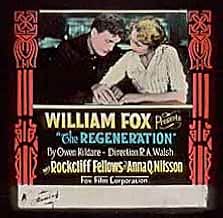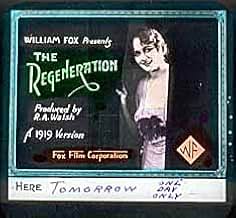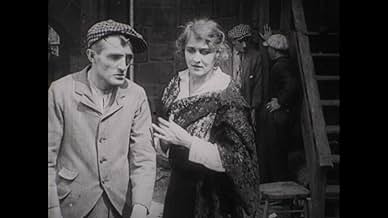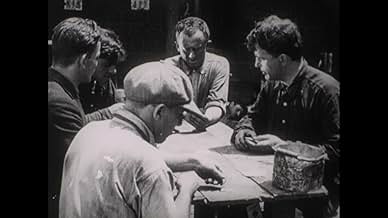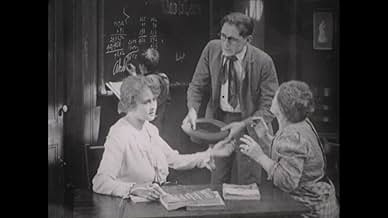PUNTUACIÓN EN IMDb
6,8/10
1,5 mil
TU PUNTUACIÓN
Añade un argumento en tu idiomaA boy surrounded by violence grows up to become an infamous gangster.A boy surrounded by violence grows up to become an infamous gangster.A boy surrounded by violence grows up to become an infamous gangster.
- Dirección
- Guión
- Reparto principal
- Premios
- 1 premio en total
James A. Marcus
- Jim Conway
- (as James Marcus)
Harry McCoy
- Owen - Age 17
- (as H. McCoy)
Peggy Barn
- Woman
- (sin acreditar)
William Dyer
- Drunk Friend of Jim Conway
- (sin acreditar)
Reseñas destacadas
I became obsessed with this movie two years ago after checking it out of our great NYC library. I rave about it to my friends. To think that this full-length feature was made in l915 is astounding. Maybe it's because of its amazing star, Rockliffe Fellowes, who looks so much like Marlon Brando you'll be double-takes. That he never became a legendary star is a real tragedy but when you think of it, almost none of the film actors from that era survived into the 20s except for Mary Pickford and a few comedians. Rockcliffe is so natural, as is his co-star, the beautiful Anna Q. Nillsen, you have to remind yourself that they were acting. This movie should be studied in film courses to show today's younger movie buffs what dynamic work was being done back int he "dinosaur" age of films. And maybe, like myself, they'll never forget the fantastic Rockliffe Fellowes. This guy "coulda been a contendah!"
Raoul Walsh had just come off _The Birth of a Nation_ both as one of Griffith's assistant directors and as an actor (most prominently as John Wilkes Booth), when he made this film. In his autobiography, Walsh credits Griffith with "teaching" him not only about much of the art of fiction filmmaking, but also about production management technics that aided him in taking full advantage of many of New York City's most pictorial exterior locations.
The locations play an important role in adding to the naturalism of an otherwise highly melodramatic plot with the high society young woman turned heroine social worker (much overplayed by a major star of the 1910s, Anna Q Nilsson) and the regeneration of the one-time Lower Manhatan gang leader.
The wonder of this film is the performance of the male "star", Rockliffe Fellowes, who played in over a dozen nearly unremembered films until he died in 1950. His performance is so subtly varied and electrically alive that one is reminded of Brando in his early 1950s films. An interesting sidenote about his performance: The movieola film editing machine -- that magnified the small 35mm frame to about 4 inches by 6 inches as it ran the film stock through the viewer at the proper projection speed -- was not invented until much later. In 1915, editors had to hold the footage up to the light to see each frame and/or use a magnifying glass; but they could not also run the film at speed at the same time. Hence, many of the subtlest nuances that cross the hero's face could not be clearly seen and judged in editing: _Regeneration's_ editor often cuts away before the movement has settled, or cuts into a close or medium shot of the hero after the nuance has already begun.
Watching the film on a large screen today, one is aware how powerful present-day editing technics are at capturing all such movements in the hands of a skilled editor. In _Regeneration_ there is a distinct feeling of rough editing at the moments we leave or cut to the hero at the "wrong" instant. By the way, the original title was NOT _The Regeneration_, but _Regeneration_ alone. From which we can surmise that Walsh was looking to create a work with universal meaning.
The locations play an important role in adding to the naturalism of an otherwise highly melodramatic plot with the high society young woman turned heroine social worker (much overplayed by a major star of the 1910s, Anna Q Nilsson) and the regeneration of the one-time Lower Manhatan gang leader.
The wonder of this film is the performance of the male "star", Rockliffe Fellowes, who played in over a dozen nearly unremembered films until he died in 1950. His performance is so subtly varied and electrically alive that one is reminded of Brando in his early 1950s films. An interesting sidenote about his performance: The movieola film editing machine -- that magnified the small 35mm frame to about 4 inches by 6 inches as it ran the film stock through the viewer at the proper projection speed -- was not invented until much later. In 1915, editors had to hold the footage up to the light to see each frame and/or use a magnifying glass; but they could not also run the film at speed at the same time. Hence, many of the subtlest nuances that cross the hero's face could not be clearly seen and judged in editing: _Regeneration's_ editor often cuts away before the movement has settled, or cuts into a close or medium shot of the hero after the nuance has already begun.
Watching the film on a large screen today, one is aware how powerful present-day editing technics are at capturing all such movements in the hands of a skilled editor. In _Regeneration_ there is a distinct feeling of rough editing at the moments we leave or cut to the hero at the "wrong" instant. By the way, the original title was NOT _The Regeneration_, but _Regeneration_ alone. From which we can surmise that Walsh was looking to create a work with universal meaning.
Directed by Raoul Walsh, this is an exciting and poetic film, using all the elements at play in his greatest movies. Those signatures really stand out, even all the way back at the beginning of his career.
It's the story of a tenement street kid who loses his kindly mother at age 10. (The scene that starts the film is quite moving. This is not to be a comic adventure film, but a very serious drama). The boy is taken in by a neighbor woman, a harridan, but a kind hearted one whose husband is a drunkard who beats her and the boy every chance he gets. The boy starts to lose whatever humanity he had, due to the influence of this battling couple.
He rises to a position of 'prominence' in the tenement community over the years, since he has all the things that the denizens of the street find attractive - a devil may care attitude, a sense of daring, a lot of strength and good looks. He's never lost his inner gentle nature, but it's hidden under a mask of bravado and cynicism that he needs to survive. The actor, Rockcliffe Fellowes, looks like a cross between Marlon Brando, Jimmy Cagney and Jason Segal. He's quite good... in fact he totally reminds me of Brando in THE WILD ONE. The camera loves him. As Owen, he's able to play both sensitive and tough, which is a magic combination for Walsh.
He falls for Marie whom he calls Mamie Rose (Anna Q.Nilsson), a wealthy girl who is being groomed by her parents for marriage to the city's new District Attorney. The DA has just been appointed and tells all the newspapers that he is cracking down on crime. One night, the girl tells the DA that she wants to see what the street toughs are like for herself. The DA tells her and her friends that he knows a dive where they can see all the lowlifes they want to. Of course, after having his picture in the papers all over town, the DA is immediately recognized and the crowd starts to heckle him showing him how tough they really are. The girl cries out for someone to help the foolish DA, and our Owen breaks up the crowd and leads them to safety. Owen is smitten, and Mamie is struck hard with the need to help the poor and destitute.
She immediately starts work in the neighborhood, doing good deeds and handing out medicine and money to the needy. The rest is just about what you would think a Walsh film would be, with Owen trying to make good out of unrequited love for Marie, who doesn't really realize his feelings. He finds inspiration to become better educated and make something of himself through her ministrations. She turns to him as a pillar of strength when things go wrong.
His loyal pal, a street kid who has a deformity who Owen once saved from being made fun of, is a splendid actor. All of the street toughs really look like street toughs, which is refreshing and a bit scary. Walsh builds up the action in a very similar way to The Roaring Twenties, with a really evil gang leader who takes over when Owen tries to goes straight. There was a surprise ending, for me anyway.This film was very well done for the time it was made and I can see how it made Walsh famous. It made me love him all the more for his sensitivity and realism.
It's the story of a tenement street kid who loses his kindly mother at age 10. (The scene that starts the film is quite moving. This is not to be a comic adventure film, but a very serious drama). The boy is taken in by a neighbor woman, a harridan, but a kind hearted one whose husband is a drunkard who beats her and the boy every chance he gets. The boy starts to lose whatever humanity he had, due to the influence of this battling couple.
He rises to a position of 'prominence' in the tenement community over the years, since he has all the things that the denizens of the street find attractive - a devil may care attitude, a sense of daring, a lot of strength and good looks. He's never lost his inner gentle nature, but it's hidden under a mask of bravado and cynicism that he needs to survive. The actor, Rockcliffe Fellowes, looks like a cross between Marlon Brando, Jimmy Cagney and Jason Segal. He's quite good... in fact he totally reminds me of Brando in THE WILD ONE. The camera loves him. As Owen, he's able to play both sensitive and tough, which is a magic combination for Walsh.
He falls for Marie whom he calls Mamie Rose (Anna Q.Nilsson), a wealthy girl who is being groomed by her parents for marriage to the city's new District Attorney. The DA has just been appointed and tells all the newspapers that he is cracking down on crime. One night, the girl tells the DA that she wants to see what the street toughs are like for herself. The DA tells her and her friends that he knows a dive where they can see all the lowlifes they want to. Of course, after having his picture in the papers all over town, the DA is immediately recognized and the crowd starts to heckle him showing him how tough they really are. The girl cries out for someone to help the foolish DA, and our Owen breaks up the crowd and leads them to safety. Owen is smitten, and Mamie is struck hard with the need to help the poor and destitute.
She immediately starts work in the neighborhood, doing good deeds and handing out medicine and money to the needy. The rest is just about what you would think a Walsh film would be, with Owen trying to make good out of unrequited love for Marie, who doesn't really realize his feelings. He finds inspiration to become better educated and make something of himself through her ministrations. She turns to him as a pillar of strength when things go wrong.
His loyal pal, a street kid who has a deformity who Owen once saved from being made fun of, is a splendid actor. All of the street toughs really look like street toughs, which is refreshing and a bit scary. Walsh builds up the action in a very similar way to The Roaring Twenties, with a really evil gang leader who takes over when Owen tries to goes straight. There was a surprise ending, for me anyway.This film was very well done for the time it was made and I can see how it made Walsh famous. It made me love him all the more for his sensitivity and realism.
Raoul Walsh, aged 28, has already done it all : he's been a Cow-boy, an actor, and Griffith's assistant for BIRTH OF A NATION, in witch he also played Lincoln's murderer. That's certainly why his very first movies, as this "Regeneration", are already so mastered and so mature. The story of the movie is quite simple : it tells us the life of a gang leader : Owen, from his unhappy childhood to his "regeneration", thanks to Mary, a young lady, who believed in his kindness, and allows him a second chance. But beyond this classical story, this movie is both a brilliant example of Griffith's omnipotent influence on early American cinema and also a totally original and new form of cinema, for it invents the codes of the Gangster's movie and of the "Film Noir" for the years to come.
As in a Griffith's feature, the ideas of the movie are developed thanks to an original use of the editing. For instance, at the beginning of the movie, Walsh superposes a frame of Owen adult, drinking a beer, with one of the same character as a child, eating an ice cream in the exact same position. This editing has of course a narrative function it reminds us that Owen is the same character of the beginning of the movie, only few years after but it also presents him, whereas he could appears as a dangerous criminal, as the same innocent victim that he was younger. This king of narrative and yet symbolist use of the editing is both a homage to Griffith and an introduction to Walsh'own style and thematic.
Griffith's influence is also very strong in the movie's will to be spectacular. When Walsh wants to show how Owen tries to change in the contact of Mary, he creates for instance a gigantic fire on a boat, where Owen risks his life saving children. Of course, we're not really in the bigger than life world of INTOLERANCE or of BIRTH OF A NATION, but still, it's the same spectacular idea of the cinema that Walsh and Griffith share. In 1915, Raoul Walsh is certainly still in the shadow of Griffith, but "Regeneration" is a lot more than a copy of Griffith's cinema, and can be fully appreciates without its relation to its style.
The movie is particularly realistic and has nothing to see with Griffith traditional romanticism. It's the adaptation of an ex-criminal autobiography, and Walsh is really good in showing sordid and realistic details, especially in the description of Owen's terrible childhood. The movie is surprisingly strong, violent and realistic for its age. But Walsh also adds to this realistically point of view, a sort or mythification of his Gangster's character, who almost become an icon, witch we'll find again in the all American Cinema to come, from Hawks 's SCARFACE, to Scorsese's movies. Fiction is already torn between realism and myth, and a large part of Walsh's Cinema will develops this thematic, as in his absolute masterpiece : THEY DIED WITH THEIR BOOTS ON.
The realism of the movie even goes with the myth, for it's mostly in the realistically description of a gangster's everyday life that the "Film Noir" will takes its future codes. Owen and his gang spend most of their time doing nothing : they walk on the docks, in the streets or drinks in clubs, but we almost never see them in action. Or when we do, we see them doing good things, for action time is in the movie regeneration time. Morality is in Walsh'Cinema a rhythm question. Inaction and immobility stuck to the Gangster's life, whereas action and movements is associated to honesty and to the opportunity to grab a good life.
That's how « Regeneration » always seems to be torn between external (Griffith/Walsh) and internal (realism/myth) conflicts, that are the extension of Owen's inner fights between a honest's life and a gangster's one, between the soft world of Mary, and the harsh and masculine one of the Gang. The end of the movie literally destroys this psychological conflict, when the two characters that symbolized each side both died. After having destroyed the two conflicted sides of his personality, Owen's life can really begins, as well as Walsh's cinema.
As in a Griffith's feature, the ideas of the movie are developed thanks to an original use of the editing. For instance, at the beginning of the movie, Walsh superposes a frame of Owen adult, drinking a beer, with one of the same character as a child, eating an ice cream in the exact same position. This editing has of course a narrative function it reminds us that Owen is the same character of the beginning of the movie, only few years after but it also presents him, whereas he could appears as a dangerous criminal, as the same innocent victim that he was younger. This king of narrative and yet symbolist use of the editing is both a homage to Griffith and an introduction to Walsh'own style and thematic.
Griffith's influence is also very strong in the movie's will to be spectacular. When Walsh wants to show how Owen tries to change in the contact of Mary, he creates for instance a gigantic fire on a boat, where Owen risks his life saving children. Of course, we're not really in the bigger than life world of INTOLERANCE or of BIRTH OF A NATION, but still, it's the same spectacular idea of the cinema that Walsh and Griffith share. In 1915, Raoul Walsh is certainly still in the shadow of Griffith, but "Regeneration" is a lot more than a copy of Griffith's cinema, and can be fully appreciates without its relation to its style.
The movie is particularly realistic and has nothing to see with Griffith traditional romanticism. It's the adaptation of an ex-criminal autobiography, and Walsh is really good in showing sordid and realistic details, especially in the description of Owen's terrible childhood. The movie is surprisingly strong, violent and realistic for its age. But Walsh also adds to this realistically point of view, a sort or mythification of his Gangster's character, who almost become an icon, witch we'll find again in the all American Cinema to come, from Hawks 's SCARFACE, to Scorsese's movies. Fiction is already torn between realism and myth, and a large part of Walsh's Cinema will develops this thematic, as in his absolute masterpiece : THEY DIED WITH THEIR BOOTS ON.
The realism of the movie even goes with the myth, for it's mostly in the realistically description of a gangster's everyday life that the "Film Noir" will takes its future codes. Owen and his gang spend most of their time doing nothing : they walk on the docks, in the streets or drinks in clubs, but we almost never see them in action. Or when we do, we see them doing good things, for action time is in the movie regeneration time. Morality is in Walsh'Cinema a rhythm question. Inaction and immobility stuck to the Gangster's life, whereas action and movements is associated to honesty and to the opportunity to grab a good life.
That's how « Regeneration » always seems to be torn between external (Griffith/Walsh) and internal (realism/myth) conflicts, that are the extension of Owen's inner fights between a honest's life and a gangster's one, between the soft world of Mary, and the harsh and masculine one of the Gang. The end of the movie literally destroys this psychological conflict, when the two characters that symbolized each side both died. After having destroyed the two conflicted sides of his personality, Owen's life can really begins, as well as Walsh's cinema.
Raoul Walsh had been an actor and an understudy assistant director under D. W. Griffith when Fox Films hired him to direct his first feature film, September 1915's "Regeneration." Many cite Walsh's full-length directorial debut as cinema's first gangster feature film.
Walsh had run away from home at 15 and worked a series of laborious, dangerous jobs, including a cow hand and a seafarer. His hands at that time were so calloused he refused to shake hands. Because of his horse-riding skills, D. W. Griffith hired him as an actor, with one of his first roles as a young version of Mexican revolutionist Pancho Villa.
Walsh showed enough of a curiosity of filmmaking that Griffith took him on as an assistant director, most notably helping him out in "The Birth of a Nation." In the 1915 film, Walsh also plays John Wilkes Booth, who kills Abraham Lincoln. Newly formed Fox Films Corporation heard and saw so many good things from Walsh that William Fox hired him to do one of his studio's first feature films.
"Regeneration," adapted from a 1908 play based on Owen Kildare's autobiography, was a redemption tale of a boy who grew up to become a criminal, but eventually realizing the wrongs he had committed through the guiding influence of a female social worker. Walsh decided to film in New York City's poor Lower East Side using actual criminals and prostitutes to heighten his movie's authenticity.
Elements of Griffith, who Walsh labeled as his teacher, is clearly visible in "Regeneration:" the masking of the lens, the parallel editing and camera positioning, numerous close ups and implementing newly devised cinematic techniques such as a handful of dolly movements. Certain scenes Walsh filmed contained chiaroscuro lighting, anticipating Germanic Expressionism film aesthetics by a few years.
Walsh would become one of Hollywood's auteurs noted for his hard-hitting, macho crime movies such as 1939's "The Roaring Twenties," 1941 "High Sierra," and 1949's "White Heat." He would direct until his final film in 1964, and have a script of his produced as a movie in 1970.
Walsh had run away from home at 15 and worked a series of laborious, dangerous jobs, including a cow hand and a seafarer. His hands at that time were so calloused he refused to shake hands. Because of his horse-riding skills, D. W. Griffith hired him as an actor, with one of his first roles as a young version of Mexican revolutionist Pancho Villa.
Walsh showed enough of a curiosity of filmmaking that Griffith took him on as an assistant director, most notably helping him out in "The Birth of a Nation." In the 1915 film, Walsh also plays John Wilkes Booth, who kills Abraham Lincoln. Newly formed Fox Films Corporation heard and saw so many good things from Walsh that William Fox hired him to do one of his studio's first feature films.
"Regeneration," adapted from a 1908 play based on Owen Kildare's autobiography, was a redemption tale of a boy who grew up to become a criminal, but eventually realizing the wrongs he had committed through the guiding influence of a female social worker. Walsh decided to film in New York City's poor Lower East Side using actual criminals and prostitutes to heighten his movie's authenticity.
Elements of Griffith, who Walsh labeled as his teacher, is clearly visible in "Regeneration:" the masking of the lens, the parallel editing and camera positioning, numerous close ups and implementing newly devised cinematic techniques such as a handful of dolly movements. Certain scenes Walsh filmed contained chiaroscuro lighting, anticipating Germanic Expressionism film aesthetics by a few years.
Walsh would become one of Hollywood's auteurs noted for his hard-hitting, macho crime movies such as 1939's "The Roaring Twenties," 1941 "High Sierra," and 1949's "White Heat." He would direct until his final film in 1964, and have a script of his produced as a movie in 1970.
¿Sabías que...?
- CuriosidadesMost of the extras in this film were real locals from the Bowery area, as well as from Hell's Kitchen, and had never appeared before in films. Most of the gangster characters were actual gangsters in real life.
- Citas
District Attorney Ames: Very fine and loyal, my boy, but you can't save your friend, and you have lost whatever chance you had - with her.
- Créditos adicionalesThere is no cast list during the opening credits or at the end. Actors, however, are credited by intertitles as they appear within the movie, and that is used for the IMDb cast ordering. Actors never mentioned are marked uncredited.
- Versiones alternativasKino International released a version which runs 72 minutes and contains an uncredited piano score.
Selecciones populares
Inicia sesión para calificar y añadir a tu lista para recibir recomendaciones personalizadas
Detalles
- Fecha de lanzamiento
- País de origen
- Idioma
- Títulos en diferentes países
- Возрождение
- Localizaciones del rodaje
- Hudson River, Nyack, Nueva York, Estados Unidos(burning of the excursion barge)
- Empresa productora
- Ver más compañías en los créditos en IMDbPro
- Duración
- 1h 12min(72 min)
- Color
- Mezcla de sonido
- Relación de aspecto
- 1.33 : 1
Contribuir a esta página
Sugerir un cambio o añadir el contenido que falta

